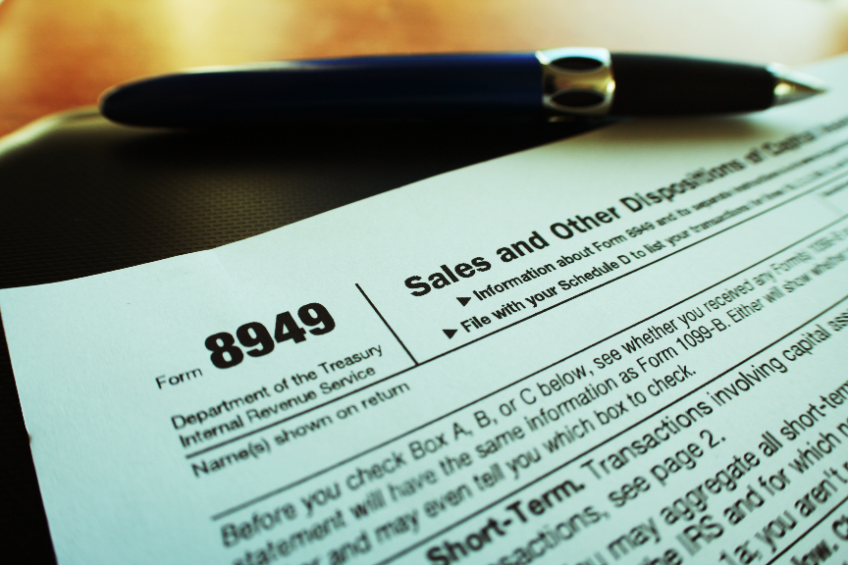
Here’s another one for the books: Form 8949
Form 8949 is for reporting capital gains and losses from the sale of assets. This includes both short-term and long-term transactions, as well as gains or losses from the sale of capital assets. The form is used to report the correct cost basis and description of property, and is accompanied by either a 1099-B form or the taxpayer’s own records of the transaction. Form 8949 is an essential part of a taxpayer’s tax return, and accuracy in reporting gains and losses is crucial to avoid potential penalties or further scrutiny from the IRS.
Do I Have to Report All Investment Transactions on Form 8949?
If you’ve bought or sold stocks, bonds, mutual funds or other items through a broker, it is important to know which types of investment transactions must be reported on Form 8949 for tax purposes. Typically, your broker will report the basis on your 1099-B form, but certain transactions will need to be reported on Form 8949.
First, any distributed or undistributed capital gains must be reported. When you own shares of a mutual fund, for example, the fund may distribute any capital gains to shareholders, either in cash or by reinvesting the gains in new shares. These gains must be reported on Form 8949.
Next, if you sell your main home, you must report the sale on Form 8949. However, if the gain from the sale is within the exclusion limit ($250,000 for single taxpayers and $500,000 for married taxpayers filing jointly), you do not have to report the sale on your tax return.
Form 8949 must also be used to report any capital losses from the sale of capital assets, such as stocks and bonds, held for personal use. Additionally, if you dispose of inherited assets, you must report the transaction on Form 8949.
It’s important to note that not all capital gains and losses require Form 8949. If your 1099-B has the correct basis and doesn’t need changing, then Form 8949 may not be necessary.
Long-Term vs. Short-Term Transactions
As an investor, it’s important to understand the difference between long-term and short-term transactions. Long-term transactions occur when you hold an investment for more than a year before selling it. On the other hand, short-term transactions refer to investments you hold for a year or less before selling.
One of the benefits of holding your digital assets for more than a year is that you can take advantage of the long-term gains tax rate, which is typically lower than the short-term gains tax rate. This can result in significant tax savings.
To ensure that you are maximizing your tax advantages, it’s important to keep track of your holding periods. A tax calculation software can help you track your investments and holding periods, making it easier to optimize your tax strategy.
When it comes to reporting investment transactions on Form 8949, it’s important to separate your capital gains and losses by their holding period. Long-term gains should be reported separately from short-term gains. This is because the tax rates for each are different.
Investment transactions that should be reported on Form 8949 include distributed or undistributed capital gains, sale of capital assets held for personal use, and disposed of inherited assets.
Capital Asset Transaction Definition
A capital asset transaction refers to any sale or exchange of a capital asset that is held by the taxpayer, whether personal or investment, with few exceptions. When filling out Form 8949 for tax reporting purposes, it’s important to identify which transactions are considered capital assets, as they are subject to capital gains tax.
A capital asset can refer to a wide variety of property types, including but not limited to stocks, bonds, mutual funds, real estate, and artwork. It’s important to note that not all transactions are considered capital assets. For example, items that are bought and sold for inventory, such as those in the course of business, are not considered capital assets for tax purposes.
Taxpayers should also be aware that the definition of a capital asset can differ for tax purposes compared to other contexts. For instance, a property may be classified as a capital asset for tax purposes, but not for accounting purposes or under state property laws.
What is a Cost Basis?
In the world of investments, the cost basis is an important concept that you need to understand. At its most basic, the cost basis is the original value of a capital asset. However, it is not as simple as the price the asset was purchased for. The cost basis is determined by a variety of factors that affect the initial purchase price.
For example, if you purchase stocks, broker commissions and fees will increase the cost basis of your investment. Additionally, for real estate, the cost basis can be adjusted for factors such as depreciation.
There are several events that can affect the cost basis as well. If a stock splits, for instance, the cost basis is adjusted. Similarly, mergers and spinoffs of companies can also impact the cost basis, as can stock dividends.
The reason it is essential to calculate the correct cost basis is that it determines the amount of taxable gain or loss when a capital asset is sold. The cost basis is subtracted from the sale price to determine the gain or loss. If the cost basis is incorrect, it can significantly affect the amount of taxes owed or the amount of a tax refund.
There are several methods for calculating cost basis, including first in, first out (FIFO), last in, first out (LIFO), specific identification, and average cost. FIFO is the most commonly used method. It assumes that the first shares purchased are the first shares sold.
LIFO, on the other hand, assumes that the most recently purchased shares are the first to be sold. Specific identification allows you to identify which specific shares you are selling, while average cost calculates the average cost per share to determine the cost basis.
It’s crucial to accurately calculate the cost basis to avoid erroneous tax reporting and ensure compliance with tax laws. The adjusted basis, which includes the original cost basis and any adjustments, is crucial in determining taxable gain or loss.
Calculating the Correct Basis
When it comes to filing your taxes, accurately calculating the correct basis for your capital assets is crucial. Knowing how to calculate the proper basis will help you determine the correct amount of taxable gain or loss when you decide to sell the asset. There are different factors to consider when calculating the correct basis for capital assets, which we’ll outline below.
To start with, the basis for capital assets is generally the purchase price of the asset, including any fees or commissions paid at the time of purchase. Make sure to keep a record of these costs to ensure that they are included in your basis calculation.
The next step is to adjust the basis for any additional costs that you incurred when acquiring the asset. This may include legal fees or transfer taxes. These additional costs increase the basis of the asset and, therefore, reduce the amount of taxable gain when you eventually sell the asset.
If you inherited the asset, the basis is generally the fair market value of the asset at the time of the previous owner’s death. This is known as the stepped-up basis. You have the option to use the fair market value or the original purchase price of the asset as the basis, whichever is more advantageous to you.
If you received the asset as a gift, the basis is generally the same as the basis of the person who gave you the gift. This means that if the person who gave you the gift held the asset for many years and had a low basis, you could be faced with a larger capital gain when you decide to sell the asset.
If you received the asset as part of a tax-free exchange, such as a like-kind exchange, the basis is generally the same as the basis of the property you gave up. This means that the basis of the asset you received is transferred over from the asset you traded.
Schedule D vs Form 8949: What do I do first?
In order to complete Schedule D, a taxpayer must fill out Form 8949 first. The information from Form 8949 is then carried over to Schedule D to calculate the total capital gain or loss for the tax year. Many taxpayers may wonder if they can complete Schedule D without Form 8949, or if these forms are interchangeable. The short answer is no, Schedule D cannot be completed without the information on Form 8949.
Schedule D is used to report the total short-term gain or loss and total long-term gain or loss from all capital asset transactions, including stocks, bonds, and real estate. This form requires a taxpayer to calculate their net capital gain or loss, which is then included on their tax return.
In contrast, Form 8949 is used to report information for each individual capital asset transaction that is sold or exchanged during the tax year. This form requires a taxpayer to provide detailed information for each asset, such as the description of the property, purchase price, purchase date, selling price, and selling date.

Sarah Nieschalk
Sarah E. Deierlein Nieschalk, EA, is an experienced tax professional with over a decade of expertise representing taxpayers before the IRS. As an Enrolled Agent and Assistant Vice President of Servicing at Community Tax, LLC, Sarah specializes in resolving complex federal and state tax collection issues, including high-dollar individual liabilities, employment tax challenges, and corporate audits. Since becoming an Enrolled Agent in 2012, she has resolved over 5,000 cases, saving millions for clients while protecting countless businesses. Outside of work, Sarah enjoys painting, staying active, and raising her family of rescued dogs while contributing to nonprofit causes through storytelling events.







